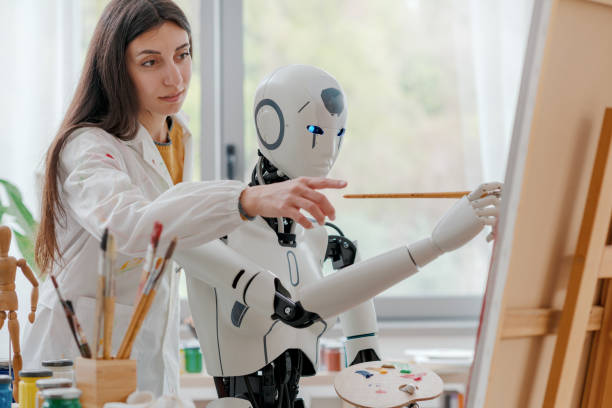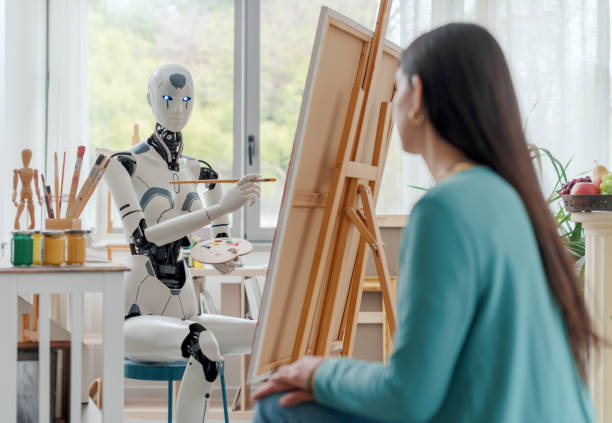Canvas Artificial Intelligence
Nowadays, technology has fused with art so many remarkable new things have been achieved. Together with the other landmarks of innovation, Canvas Artificial Intelligence represents an exceptional evolution exponent that substantially changes how we perceive and interact with artistic expression. Integrating AI into the workflow facilitates this innovative technology by uncovering realms that have been unexplored, increasing the potency of creation and efficiency. In this post, we explore the world of Canvas Artificial Intelligence, highlighting its features, importance, and roles that it plays for artists, industrial creators and other industries.

Understanding Canvas Artificial Intelligence:
ATC (Artificial Canvas) stands for the combination of the traditional art media and complex machine learning algorithms. It, at the same time utilizes the raw computing power of AI to amplify, boost, and sometimes create art. The canvas is no longer a static surface where artwork has been created conventionally, it is a dynamic interface where creativity collaborates with the help of intelligent algorithms to produce digital masterpieces.
Applications Across Industries:
The industrial uses of Canvas Artificial Intelligence range from many different industries beyond that. It allows brands to innovate with the help of well-designed visual stories that capture the attention of the niche market they are targeting in the realm of digital marketing. Indeed, AI-driven canvases are capable of analyzing consumer preferences and trends in the present moment, which brings the possibility to modify content in a real-time mode, boosting engagement and impact.
Furthermore, Canvas Artificial Intelligence is the starting point for the revolution of architecture and design. Designers have the ability to utilize the technology to its fullest capabilities to create visuals, iterate quickly, and explore unconventional ideas with the ease never been achieved. Using AI-powered canvas either in visualization of futuristic structures or in logic-based designing of interior layouts, creativity of architects will take a quantum leap, hence unleashing the power of their imagination.
Artistic Empowerment and Collaboration:
Canvas has changed the image of the workflow for an artist, opening new opportunities for the manifestation of creativity.
AI(artificial intelligence) as a collaborator, creatives can overpass technical barriers and develop something unusual, getting to the new horizons of their craft. By creating intertwined complex textures to automating the monotonous tasks, machine-artificial intelligence empower artists to concentrate on the core of their creativeness, thus setting up an equilibrium between human imagery and cognitive machine intelligence.

Besides Canvas Artificial Intelligence brings teams to work on the largest scale answered to all times. Cloud-based platforms and collaborative tools, in fact, allow artists to exchange canvases, receive peers’ feedback and jointly create with colleagues from all over the world. This canopy of relationships not only quickens innovation but also grows the ecosystem, which nurtures a living village, where ideas proliferate and artistic boundaries depart.
Challenges and Ethical Considerations:
Undoubtedly, Canvas Artificial Intelligence is a transformative tool which nevertheless comes with its share of challenges and debates about ethics. With AI algorithms evolving in the future, authorship, ownership, and authenticity tend to be very huge issues. The question of what “art” is is more and more complicated in a context where machines are now not only playing a support role but manipulating the creative process, as well.
Also, data privacy, bias in algorithms and unanticipated outcomes of AI-automated content are the matters that supply food for thought as well. In the position of being the stewards of this technology, creators, and innovators must adhere to ethical standards while ensuring that Canvas Artificial Intelligence is used with a capital letter in the right and moral way.
Conclusion:
After all, Canvas Artificial Intelligence is leading a disruptive creative turn, questioning the frontiers of art and progress. It achieves this by merging human creativity with machine intelligence which in the way enables individuals and businesses to explore their full revolutionary prowess. Since we go on to discover various uses of this innovative technology, it is time to embrace a future when the canvas is just not a mere surface of the artwork, but a doorway to innumerable possibilities made possible by our AI intelligence.

FAQs
What are AI’s Canvas practical usages?
Canvas Artificial Intelligence is having a broad application across a variety of industrial sectors. It is digital marketing for personalised content, architecture and design for concepts visualization and rapid prototyping, entertainment for immersive experience and virtual worlds, as well as in art creation to augment and enhance the abilities of artists.
Apart from ensuring comfort and personal care, the artworks also handle complex mental health issues and provide comfort and healing.
Humanized Canvas Artificial Intelligence empowers artists by equipping them with tools and techniques that help them with the automation of simple tasks and provides them with the unique opportunity to explore new artistic styles and possibilities. It’s a partner that augments human skills, so that artists can concentrate on the artistry aspects of the piece, leaving the AI to assist in the implementation.
How can we ethically use the Canvas artificial intelligence?
Issues of ethics about Canvas Artificial Intelligence involve who can be considered the author, owner, and authentic producer. The issues of data privacy, algorithmic bias, and the social reforms that the excessive use of AI-generated art can bring are also a big concern. It is vital to observe the issues and ensure ethical and responsible action by creators and innovators.
Is Canvas artificial intelligence usable for everyone?
Some of the most advanced Canvas Artificial Intelligence tools may be so dependent on programming expertise or the need for specialist software, but there are also the applications and platforms that make AI-driven creativity much more accessible for a wider public. As technology advances, it is becoming more like human interaction and spreading to every single field.
Which is the best way for me to begin work on the Canvas Artificial Intelligence Project?
You may find many online tutorials, courses, and communities with the purpose of conquering AI with the power of creativity. You can enjoy free trials or beginner-friendly versions of many software platforms, which means that you could explore any of them and learn at your own pace. Relevantly, you can also find forums online and other artists and creators to engage with.

